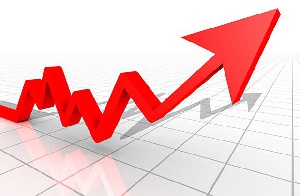 Prices of commodity keeps increasing
Prices of commodity keeps increasing
Inflation for the month of March increased slightly to 9.3 per cent from the 9.2 per cent recorded in February.
The March 2019 figure is 0.1 percentage points higher than the 9.2 per cent recorded in February this year, the Ghana Statistical Service (GSS) has said.
In March 2018, inflation was 10.4 per cent.
Food and non-food inflation
A release issued by the GSS after a press conference in Accra on Wednesday showed that the food inflation basket recorded a rate of 8.4 per cent, compared to 8.1 per cent recorded in February 2019.
The non-food basket inflation rate of 9.7 per cent in February 2019 remained unchanged in March 2019.
The main drivers of non-food inflation were recreation and culture (14.1 per cent), transport (13.7 per cent), clothing and footwear (13.3 per cent) and furnishing, household equipment and routine maintenance (12.2 per cent).
The price drivers for the food inflation rate included coffee, tea and cocoa (13 per cent), mineral water, soft drinks, fruit and vegetable juices (11.1 per cent) fruits (10.2 per cent) and meat and meat products (9.1 per cent).
Regional inflation
At the regional level, Deputy Government Statistician, David Kombat said four regions — Upper West, Brong Ahafo, Western and Ashanti — recorded inflation rates higher than the national average of 9.3 per cent.
The Volta Region recorded the same inflation as the national average, he said.
“The Upper West Region recorded the highest year-on-year inflation rate of 11.4 per cent, followed by Brong Ahafo with 10.2 per cent, while the Upper East Region recorded the lowest year-on-year inflation of 7.9 per cent in March 2019,” he said.
“We’ve seen an increase in inflation rate and it could be partly attributed to the exchange rate we’ve seen in recent weeks,” Mr Kombat said.